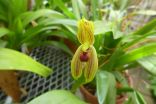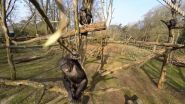(Press-News.org) MADISON, Wis. - Orchids, a fantastically complicated and diverse group of flowering plants, have long blended the exotic with the beautiful. Most species live on trees, often in remote, tropical mountains. Their flowers can be strange -- one even flowers underground, and many species deceive their pollinators into thinking they are good to eat.
Some are florist's staples, like phalaenopsis, the hot-pink and white flower that is easy to grow and easier to sell. Beyond the "job" of looking beautiful, only the vanilla orchids have any commercial role.
The estimated 25,000 orchid species outnumber mammals, reptiles and birds combined.
Previously, botanists have proposed more than a half dozen explanations for this diversity. Now, research from the University of Wisconsin-Madison, published last week in Proceedings of the Royal Society B, corroborates many of these explanations, but finds no evidence for other logical suggestions, such as that deceitful pollination.
"It was surprising that many classic characteristics of orchids -- the tiny, dust-like seeds, the role of fungi in triggering germination, the fused male-female flower parts that define the orchid flower -- did not trigger the acceleration in species formation," says Thomas Givnish, a professor of botany and first author of the new study.
To build a family tree for the orchids, the scientists sequenced genes in the green structures, called chloroplasts, in which plants transform solar energy into sugar. The researchers looked at chloroplasts from 39 species, strategically placed throughout the orchid family, then added genetic data on 150 more species. By tying their molecular family to fossils of known ages, Givnish and his colleagues created a branching structure that indicated how many million years ago each major group of orchids appeared.
Then, based on the numbers of species known in each of these groups today, the researchers were able to calculate the rate of species diversification in each and test the many putative causes of the explosion in orchid species. They found that the factors that most greatly accelerated the formation of new species were life in extensive mountain ranges (like the Andes and New Guinea Highlands); the evolution of epiphytism (life in the trees); pollination by orchid bees, moths, or butterflies; and origin of pollinia (packages of hundreds to thousands of pollen grains dispersed as a unit).
Givnish and his colleagues found that initially, orchids speciated no more rapidly than their closest relatives, and at a slow rate relative to flowering plants as a whole. Then there were three waves of accelerated speciation beginning 60, 40 and 33 million years ago. Pollinia apparently sparked the first acceleration in speciation, Givnish says. The origin of epiphytism -- and the invasion in tropical mountains with a constant swirl of clouds and rain -- sparked the second, greater acceleration. The invasion of the Andes as they were being uplifted triggered the third and greatest acceleration.
Interestingly, a surprising number of proposed explanations for orchid diversity failed the new test. Not even deceitful pollination (present in about one-third of all orchid species) was linked to accelerated speciation, Givnish says. "Orchids, almost alone among flowering plants, have a large number of species that lure pollinators by mimicking a mate, or a nesting site or food resources -- 'lies all for the sake of love' -- but such deceit seems to have played no role in accelerating the formation of new orchid species."
Chloroplasts were a useful source of DNA for the study, Givnish says. "There are thousands of chloroplasts per cell, and many loops of DNA per chloroplast, and the genome structure is quite stable." Mercedes Ames of the UW-Madison Department of Botany sequenced most of the chloroplast genomes.
Other UW-Madison collaborators included Daniel Spalink, Alejandro Zuluaga, and orchid specialist Kenneth Cameron, director of the Wisconsin State Herbarium. Collaborators in Australia and Chile provided DNA for the study, and W. Mark Whitten and Norris Williams of the University of Florida provided genetic data.
Looking at the orchids as a family, Givnish finds "not one spark for their extraordinary diversification, but many. Many hypotheses advanced by previous investigators proved to be correct, but some of the defining characteristics of orchids -- their tiny seeds, their requirement for fungi to germinate, and their fused pistils and anthers -- were not themselves responsible for the high rate of orchid speciation. Only later, when the orchids acquired pollinia, started to grow in trees, and then colonized the cloud forests along extensive mountain ranges in the tropics, did the orchids' unrivalled diversification begin."
INFORMATION:
DOWNLOAD PHOTOS: https://uwmadison.box.com/orchids
Repeated exposure to anesthesia early in life causes alterations in emotional behavior that may persist long-term, according to a study from the Icahn School of Medicine at Mount Sinai in collaboration with the Yerkes National Primate Research Center, and published in the Online First edition of Anesthesiology, the official medical journal of the American Society of Anesthesiologists®.
Each year, approximately one million children under the age of four undergo surgery with general anesthesia, according to the U.S. Food and Drug Administration (FDA). Retrospective ...
A study that used stored blood samples from U.S. Air Force personnel who conducted aerial herbicide spray missions of Agent Orange during the Vietnam war found a more than 2-fold increased risk of the precursor to multiple myeloma known as monoclonal gammopathy of undetermined significance (MGUS), according to an article published online by JAMA Oncology.
While the cause of MGUS and multiple myeloma (plasma cell cancer) remains largely unclear, studies have reported an elevated risk of multiple myeloma among farmers and other agricultural workers and pesticides have ...
CAMBRIDGE, Mass. -- The technology behind 3-D printing is growing more and more common, but the ability to create designs for it is not. Any but the simplest designs require expertise with computer-aided design (CAD) applications, and even for the experts, the design process is immensely time consuming.
Researchers at MIT and the Interdisciplinary Center Herzliya in Israel aim to change that, with a new system that automatically turns CAD files into visual models that users can modify in real time, simply by moving virtual sliders on a Web page. Once the design meets ...
CAMBRIDGE, Mass. (September 3, 2015) - In the breast, cancer stem cells and normal stem cells can arise from different cell types but tap into distinct yet related stem cell programs, according to Whitehead Institute researchers. The differences between these stem cell programs may be significant enough to be exploited by future therapeutics.
Deadly tumor-initiating cells seed metastases throughout the body and cause relapses in patients. Whether these tumor-initiating cells can also be referred to as stem cells, specifically, cancer stem cells, has been up for debate. ...
A brief series of classes to help first-time parents better support each other through the often stressful transition to parenthood has a positive effect on birth outcomes as well, according to health researchers.
A decade ago Mark Feinberg, research professor at the Bennett Pierce Prevention Research Center for the Promotion of Human Development, Penn State, developed Family Foundations, a series of classes for expectant parents. In two research trials, the program was shown to improve the way parents support each other -- to reduce parental stress, depression and anxiety; ...
AUSTIN, Texas -- Evidence from the tropical lowlands of Central America reveals how Maya activity more than 2,000 years ago not only contributed to the decline of their environment but continues to influence today's environmental conditions, according to researchers at The University of Texas at Austin.
Synthesizing old and new data, researchers were the first to show the full extent of the "Mayacene" as a microcosm of the early anthropocene -- a period when human activity began greatly affecting environmental conditions.
"Most popular sources talk about the anthropocene ...
In some patients, aggressive cancers can become resistant to chemotherapy and radiation treatments. In a paper published in the journal Nature Communications, University of California, San Diego School of Medicine researchers identified a pathway that causes the resistance and a new therapeutic drug that targets this pathway.
"It was previously known that RAF (a family of proteins that regulate cellular signaling) governs resistance to therapies. We discovered an undescribed role for RAF and learned precisely how it occurs in a broad range of cancers," said lead author ...
PHILADELPHIA -- Acupuncture may be a viable treatment for women experiencing hot flashes as a result of estrogen-targeting therapies to treat breast cancer, according to a new study from researchers at the Perelman School of Medicine at the University of Pennsylvania. Hot flashes are particularly severe and frequent in breast cancer survivors, but current FDA-approved remedies for these unpleasant episodes, such as hormone replacement therapies are off-limits to breast cancer survivors because they include estrogen. The results of the study are published this week in the ...
Montreal, September 3, 2015 -- Sleep matters for kids, especially when they are stressed. A new study led by researchers Jinshia Ly, Jennifer J. McGrath and Jean-Philippe Gouin from Concordia University's Centre for Clinical Research in Health and the PERFORM Centre shows that poor sleep might explain how stress impacts health in kids.
A good night's sleep
Getting a good night's sleep might buffer the impact of stress on kids' cortisol level, which is a hormone produced in the adrenal gland to regulate the body's cardiovascular, metabolic and immune systems. While short-term ...
Cool. Calm. And oh, so calculated. That's how a chimpanzee living in the Royal Burgers' Zoo in the Netherlands set out to swat an aerial drone that was filming her group. In an article in the journal Primates published by Springer, Jan van Hooff and Bas Lukkenaar explain it as yet another example of chimpanzees' make-do attitude to using whatever is on hand as tools.
The incident happened earlier this year, on 10 April, when a Dutch television crew was filming at the zoo in Arnhem. The idea was to use a drone to film the chimpanzees in their compound from different close-up ...


